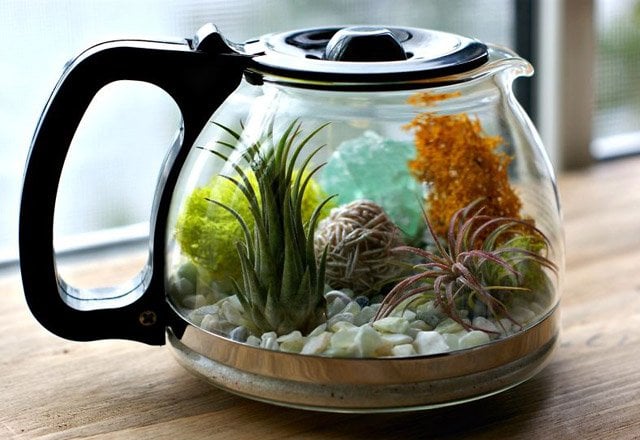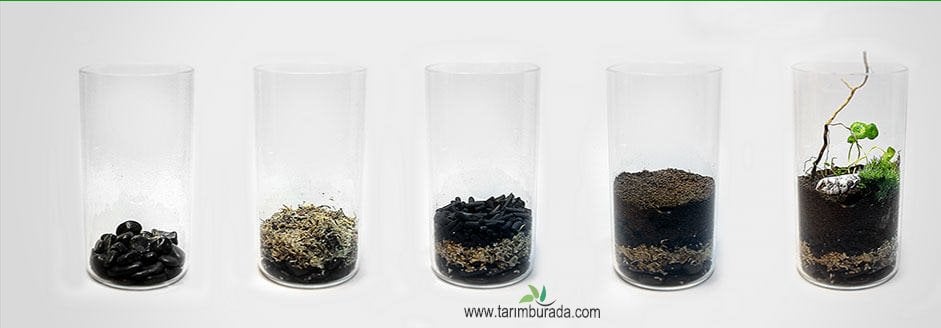Teraryum (Akvaryumda ) Bitki Yetiştirme

Teraryum aslında latince "terrarium” kelimesinden geliyor. "Terra” Toprak , "arium” da akvaryum demek. Kısacası teraryumların bir eko sisteme sahip olduklarını bilerek baktığımızda , ofisteki masalarda ya da evimizin bir köşesinde duran mükemmel görünüme sahip bir dekorasyon objesi değil, içerisindeki taşıyla, toprağıyla, nemiyle ve bitkileriyle yaşayan minik bahçeler olarak kabul edebiliriz.
Gerekli Malzemeler
Cam Fanus: Eğer ilk defa teraryum yapacak iseniz; Öle şatafatlı , büyük cam fanuslar arayışı içerisinde olmayın zaten ilk yapılan teraryumlar çoğu zaman hüsranla sonuçlanabilir. Bu yüzden evinizdeki cam şekerlikleri, içine salça koyulan büyük kavanozları ya da seramikten yapılmış derin kapları kullanabilirsiniz.
Çakıl Taşı: Bir Teraryumun olmazsa olmazı çakıl taşlarıdır. Çünkü çakıl taşları sulama yapılırken drenajı sağlayan en önemli parçadır.
Eldiven: Cam fanus gibi üzerine her dokunduğunuzda parmak izinizi emen bir obje ile çalışıyorsanız eldiven takmak zorundasınızdır. Cam fanusunuzun temiz olmasını sağlamak ve toprak, taş ve dikenli bitkilerden elinizi korumak için bahçe eldivenlerine ihtiyacınız olabilir.
Cımbız: Olmazsa olmazların başında cımbızlar gelir. Çünkü dar boğazlı ya da uzun cam fanuslar ile çalışırken parmaklarınızın girmediği yere uzun cımbızlar ile müdahale edebilirsiniz.
Torf: Terraryum bitkilerinizi ekeceğiniz toprak tipi torf denilen birşey. Fakat her torf her bitkiye göredir diye bir kural yok! Bu yüzden seçtiğiniz bitkilere özel torfu kendinizde yapabilirsiniz ağaç talaşı ile toprak karıştırmanız yeterlidir. Örneğin yapı marketlerin bahçe reyonundaki görevlilerden bitkilerinize uygun torfu isteyebilirsiniz. yada sitemizden ulaşabilirsiniz.
Sphagnum: Bu değişik isme sahip olan şey, teraryum ekosistemindeki nem dengesini sağlamak için kullanılıyor. Çakıl taşlarının üzerine dökülüp , sistemde filtre olarak görev yapıyor.
Karbon: Teraryum sisteminizin hava kalitesini arttırmak , içerisinde bakteri ve zararlı küflerin oluşumunu engellemek için karbon kullanılması şart. Peki karbon nedir? Aslında bildiğimiz kara kömür. Tek farkı büyük parçalar halinde değilde ufak toz halinde olması. İster balık satan akvaryumlardan temin edebilirsiniz , istersenizde kendiniz kömürü kırıp toz haline getirip kullanabilirsiniz.
Pruvazire Şekilde Su Fışkırtan Fısfıs: Çok havalı bir başlık gibi oldu ama aslında her evde bulunan bitmiş cam sil kutularının içerisine su doldurun işte size pruvarize su fışkırtan fısfıs. Bunu temin etmenizdeki esas amaç terraryum sisteminize can suyunu vermek.
Terraryum Sistemine Uygun Bitkiler: Ve sonunda! Teraryum sisteminiz içerisinde kullanacağınız bitkileri iyice araştırıp , öğrendikten sonra birbirleri ile iyi anlaşan bitkilerinizi seçmiş olmalısınız. Daha önce de dediğimiz gibi bitkiye para vermeden basit yollu bir teraryum yapacak iseniz; park ve bahçelerdeki duvar diplerinden yabani otları, yosunları toplayıp mini bahçenizi hazırlayabilirsiniz.
Bitkiler: İşte nihayet! En eğlenceli malzeme! Teraryum bitkilerini araştırın, okuyun, öğrenin. Seçiminizi yapın ve çiçekçinin yolunu tutun. Yosun ve minik yabani bitki örtüleri için parkların bahçelerin kuytu nemli köşelerine bakınmayı da unutmayın!

Teraryum Yapım Aşamaları
Yukarıda saymış olduğumuz tüm malzemeleri tedarik ettiğimize göre artık kolları sıvayıp ilk terraryumumuzu yapabiliriz. İlk olarak, kavanozun içinde herhangi bir kirli yüzey kalmayana kadar güzelce yıkayalım. Ardından kuru bez ile en ufak su zerresi kalmayacak şekilde kurulayalım. Herhangi bir su zerresi ya da kirli yüzey kalırsa cam fanusunuza dışardan bakıldığında kolayca göze çarpacaktır.
Sıra geldi mini dünyamızın çekirdeğini oluşturmaya. Aynı dünyamızda olduğu gibi çekirdek en sert kısım. Tüm çakıl taşlarını cam fanusumuzun en dibine eşit şekilde bir katman oluşturacak şekilde dökelim. Çakıl taşlarının en dipte olmasının sebebi ; teraryumu suladığımızda dibe çöken suyun nem oluşumunu sağlaması ve toprak için sağlam bir temel oluşturup , sistem içindeki bitkilerin kolayca çürümesini engellemesi.
Çakıl taşlarından sonra sphagnumu, eğer temin edemediyseniz elyafı, yerleştirin. Sphagnum tabakasının üzerine de aktif karbon veya kömür parçacıklarını ekleyin. Ve son katman: torf.
En alt katmandan sonra sphagnunuyu ekliyoruz. Sphagnunun üzerine toz haline getirdiğimiz kömür parçalarını ekliyoruz. Bitkilerden önce son katmanı torf’u ekledikten sonra en güzel aşamaya geçebiliriz.
Torf katmanını oluşturduktan sonra bitkileri ekmek için aynı fidan ekercesine ufak çukurlar kazıp bitkilerinizi ekin. Ekim işlemi en hassas ve en nazik davranacağınız kısım. Bu yüzden bitkilerin köklerine zarar vermeden temin ettiğiniz uzun cımbızlar ile bitkilerinizi yerleştirin. Eğer uzun ebatlı cımbız bulamadıysanız uzun çöp şişleri biz cımbız edasıyla kullanabilirsiniz. Bitkilerin yerleşiminden sonra can suyunu verip terraryum sisteminizi tamamlamış oluyoruz.
Artık Teraryumumuz kaba hatları ile tamam! Gerisi sizin hayal gücünüze kalmış. Mini bahçenizi hediye edeceğiniz kişiye ya da evinizin dekoruna göre süsleyebilirsiniz. Sevgilinize hediye edecekseniz, ufak sevgili figürlerini , bank ya da ahşap masaları sanat atölyelerinden temin edip süsleme işlemini yapabilirsiniz. Dediğimiz gibi hayal gücünüz neyi elverdiyse, onu sisteminize ekleyebilirsiniz.
Teraryum Bakımı
Teraryumu sonunda yaptık ve evimizin en güzel köşesine koyduk. Baktıkça bakasımız geliyor ve her baktığımızda gurur duyup herkese göstermek istiyoruz. Fakat bakım yapmazsak çok geçmeden yüzüne bakılmayacak hale gelebileceğinizde unutmayalım. Bu yüzden çok zor olmayan fakat dikkat edilmesi gereken birkaç püf nokta var bunları kesinlikle göz ardı etmemelisiniz.
Önceliğimiz toprak. Bitkilerin içinde olduğu torfumuzun içine kesinlike gübre katmayın. Eğer gübreleme yaparsak , bitkiler çok hızlı büyüyecek ve terraryum fanusunuz bitkilerinize dar gelecektir. Kabına sığmayan bitkiler , kendileri için ideal toprağa ulaşamadıkları için yavaş yavaş ölmeye başlayacaklardır. Bu yüzden kesinlikle gübreleme yapmadan torfun kendi besin seviyesi ile bitkilerimizi baş başa bırakıyoruz. En ideal toprak değişimi 2 yılda bir torf katmanının en üstünü yenilemektir.
Sıra geldi suya. Teraryumlar yazımızın başında da dediğimiz gibi ekosistemik yapılarında nem ve buna bağlı olacak şekilde hazırlandıklarından dolayı çok fazla suya ihtiyaç duymazlar. Çok fazla sulama fayda’dan çok zarara yol açacaktır. Çok fazla su her bitkide olduğu gibi kökleri çürütür. Teraryumunuzu sulanması gerektiğini anlamak için toprağına parmağınızla hafifçe bastırın. Bastırdığınız toprak hafi çöküyor , nefes alıyormuş gibi nemliyse sulamanıza gerek yok demektir. Fakat kuruluk hissediyorsanız çok fazla olmayacak şekilde hafifçe sulamanızda yarar var.
Ufak bir dipnot: Eğer cam fanusunuzun camları buharlanıyorsa, büyük ihtimalle fazla sulama yapmışsınız demektir. Fazla nemlenme ve buharlanma durumlarında fanusunuzun camını birkaç saaat açın ki fazla nem buharlaşıp dışarı kaçsın.
Sıra geldi her bitkide olduğu gibi en çok sorulan ve bilinmesi en çok istenilen konu ışık ve ısıya. Terraryumlar ısı ve ışığa yapıları itibari ile çok hassastırlar. Bitkiler cam fanus içerisinde yaşadıkları için direk olarak güneş ışığı ile temas ettirildiğinde camın da gücü ile bitkiler yanabilir. Teraryumlar’ın çok fazla gölgede kalmalarıda iyi birşey değildir. O zaman yine aynı klişe cümle ile karşı karşıyayız. Ne güneşte kalacak ne de gölgede:) Aslında doğru yeri siz evinizin yapısına göre belirleyeceksiniz. Çok karanlık olmayan fakat günün belli saatlerinde güneş alan fakat direk cam fanusun üzerine güneş ışınlarının düşmediği biryer teraryumunuz için en ideal yerdir. Teraryum bakımlarında en çok sorulan soruların başında cam kısmının yosun tutması ya da kavrulması sorulur. Bunların cevablarını ilk okulda gördüğümüz fen bilgisi dersinden aldık aslında. Eğer cam çok fazla güneş ışığına maruz kaldıysa o yüzey fazla yosunlaşma yapmıştır. Ve size beni biraz gölgeye al demeye çalışıyordur. Ayrıca kış aylarında kalorifer peteklerine yakın yerde duran teraryumlar kuruyup ölürler. Bu yüzden oda sıcaklığında ve kaloriferden uzak yerlerde tutmanızda yarar var.
En zor bakım işlemlerini hallettiysek sıra geldi en basiti ve sürekli yapılması gerekene. Teraryum fanusunuzu temiz tutun. Temiz tutmaktan kastımız dökülmüş , kurumuş ya da çürümüş yaprakları cam fanusunuzun içerisinden çıkarın. Fanusunuzun camının her daim temiz görünmesini sağlamak sürekli tozunu alın. Temizliğinizi yaparkende su harici başka hiçbir kimyasal temizlik maddesi kullanmayın.
